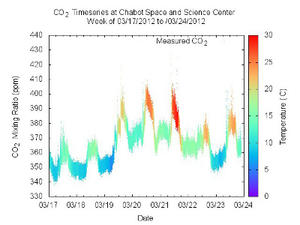Infrastructure protectionFirst-of-its-kind CO2 sensor network deployed in Oakland
The City of Oakland will be ground zero for the first urban sensor network to provide real-time, neighborhood-by-neighborhood measurements of carbon dioxide and other air pollutants; the prototype network, being installed by chemists at the University of California, Berkeley, will employ forty sensors spread over a twenty-seven square-mile grid

CO2 concentration shown graphically over one week period // Source: berkeley.edu
The City of Oakland will be ground zero for the first urban sensor network to provide real-time, neighborhood-by-neighborhood measurements of carbon dioxide and other air pollutants.
The prototype network, being installed by chemists at the University of California, Berkeley, will employ forty sensors spread over a twenty-seven square-mile grid, most of them mounted atop local schools to engage students in the project. A University of California, Berkeley release reports that the information the network will provide could be used to monitor local carbon dioxide emissions to check on the effectiveness of carbon-reduction strategies now mandated by the state, but hard to verify.
“Today, we monitor air quality in the entire East Bay from only about a dozen stations, but that gives you an average that may not be representative of what’s happening where you live,” said project leader Ron Cohen, UC Berkeley professor of chemistry. “The advantage of many, many sensors is that the network captures the whole range of pollutant sources, from freeways to homes. This could inspire communities to think about local actions to change the CO2 they emit.”
The state has committed to a cap and trade strategy as an attempt to lower carbon emissions, and the Bay Area Air Quality Management District instituted a carbon fee on regional businesses in 2008. Carbon taxes, however, rely on reports by local agencies and businesses that estimate their emissions based on assumptions that may be wrong, such as the amount of carbon dioxide emitted when pouring concrete.
UC Berkeley graduate student Virginia (Jill) Teige, who designed the sensors, said “no one is actually measuring CO2 at a fine enough resolution to confirm whether the reports are right or not. The idea of putting up a network to monitor emissions is like measuring how fast everyone is driving in order to confirm that people are abiding by the speed limit.”
Built and installed by Cohen, Teige and their lab colleagues, the shoebox-size sensors will continuously measure carbon dioxide, carbon monoxide, nitrogen dioxide and ozone levels as well as temperature, pressure and humidity, streaming the information live to the project’s Web site.
“One of my fantasies is that the local news will show a video of the day’s changing CO2 levels, just as it shows the movement of weather fronts,” Cohen said.
The sensor network, dubbed BEACON (Berkeley Atmospheric CO2 Observing Network), stretches from the East Bay Regional Parks on the east to Interstate
